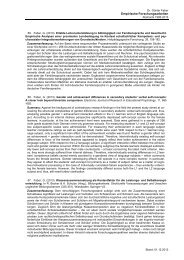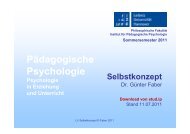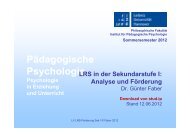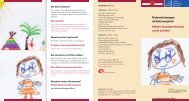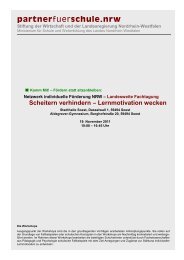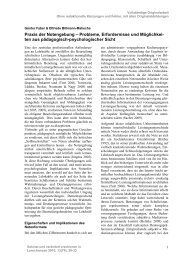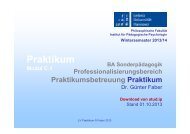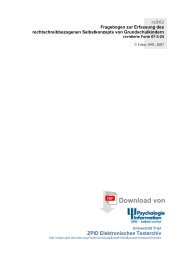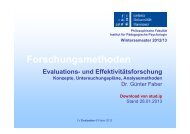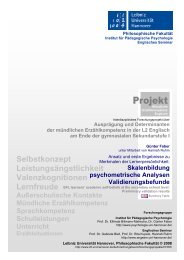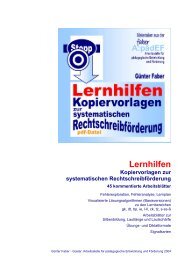Selbstkonzept, Kausalattributionen und Leistungsangst - Institut für ...
Selbstkonzept, Kausalattributionen und Leistungsangst - Institut für ...
Selbstkonzept, Kausalattributionen und Leistungsangst - Institut für ...
Sie wollen auch ein ePaper? Erhöhen Sie die Reichweite Ihrer Titel.
YUMPU macht aus Druck-PDFs automatisch weboptimierte ePaper, die Google liebt.
onsbeschreibung <strong>und</strong> Möglichkeiten der Prävention (S. 85-129). Köln: Heymanns.<br />
Günter Faber<br />
Schwarzer, R., Seipp, B. & Schwarzer, C. (1989). Mathematics performance and anxiety: A metaanalysis.<br />
In R. Schwarzer, H.M. van der Ploeg & C.D. Spielberger (Eds.), Advances in test anxiety<br />
research. Volume 6 (pp. 105-119). Lisse: Swets and Zeitlinger.<br />
Sepie, A.C. & Keeling, B. (1978). The relationship between types of anxiety and <strong>und</strong>er-achievement<br />
in mathematics. Journal of Educational Research, 72, 15-19.<br />
Shavelson, R.J., Hubner, J.J. & Stanton, G.C. (1976). Self-concept: Validation of construct interpretations.<br />
Review of Educational Research, 46, 407-441.<br />
Simpson, S.M., Licht, B.G., Wagner, R.K. & Stader, S.R. (1996). Organization of children’s academic<br />
ability-related self-perceptions. Journal of Educational Psychology, 88, 387-396.<br />
Skaalvik, E.M. (1990). Gender differences in general academic self-esteem and in success expectations<br />
on defined academic problems. Journal of Educational Psychology, 82, 593-598.<br />
Skaalvik, E.M. (1994). Attribution of perceived achievement in school in general and in math and<br />
verbal areas: Relations with academic self-concept and self-esteem. British Journal of Educational<br />
Psychology, 64, 133-143.<br />
Skaalvik, E.M. (1997). Self-enhancing and self-defeating ego orientation: Relations with task and<br />
avoidance orientations, achievement, self-perceptions, and anxiety. Journal of Educational Psychology,<br />
89, 71-81.<br />
Skaalvik, E.M. & Hagtvet, K.A. (1990). Academic achievement and self-concept: An analysis of<br />
causal predominance in a developmental perspective. Journal of Personality and Social Psychology,<br />
58, 292-307.<br />
Skaalvik, E.M. & Rankin, R.J. (1990). Math, verbal, and general academic self-concept: The internal/external<br />
frame of reference model and gender differences in self-concept structure. Journal<br />
of Educational Psychology, 82, 546-554.<br />
Skaalvik, E.M. & Rankin, R.J. (1995). A test of the internal/external frame of reference model at<br />
different levels of math and verbal self-perception. American Educational Research Journal, 32,<br />
161-184.<br />
Skaalvik, E.M., Valans, H. & Sletta, O. (1994). Task involvement and ego involvement: Relations<br />
with academic achievement, academic self-concept and self-esteem. Scandinavian Journal of<br />
Educational Research, 38, 231-243.<br />
Skaalvik, E.M. & Valås, H. (1999). Relations among achievement, self-concept, and motivation in<br />
mathematics and language arts: A longitudinal study. Journal of Experimental Education, 67,<br />
135-149.<br />
Skaalvik, E.M. & Valås, H. (2001). Achievement and self-concept in mathematics and verbal arts:<br />
A study of relations. In R.J. Riding & S.G. Rayner (Eds.), Self-perception. International perspectives<br />
on individual differences. Volume 2 (pp. 221-238). Westport: Ablex.<br />
Sparfeldt, J.R., Schilling, S.R., Rost, D.H., Stelzl, I. & Peipert, D. (2005). Leistungsängstlichkeit:<br />
Facetten, Fächer, Fachfacetten? Zur Trennbarkeit nach Angstfacette <strong>und</strong> Inhaltsbereich. Zeitschrift<br />
<strong>für</strong> Pädagogische Psychologie, 19, 225-236.<br />
Stevenson, H.W. & Newman, R.S. (1986). Long-term prediction of achievement and attitudes in<br />
mathematics and reading. Child Development, 57, 646-659.<br />
Stiensmeier-Pelster, J. (1994). Attribution <strong>und</strong> erlernte Hilflosigkeit. In F. Försterling & J. Stiensmeier-Pelster<br />
(Hrsg.), Attributionstheorie. Gr<strong>und</strong>lagen <strong>und</strong> Anwendungen (S. 185-211). Göttingen:<br />
Hogrefe.<br />
98



